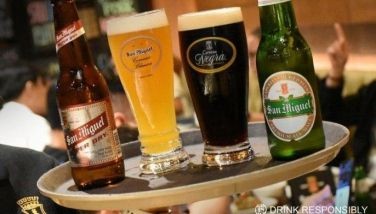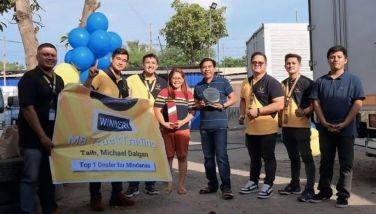Amazing race

Cloud Nine is what they call that portion of Siargao’s coastline most favored by surfers from all over the world.
There is a small debate over how that strip of shoreline got its name.
Surigao del Norte’s tireless governor Ace Barbers submits anecdotal evidence. He says hardcore surfers from Australia and Germany, the first pilgrims to this beach, would sit on the shore the whole day waiting for the right waves to happen. While at it, they would consume nothing but Cloud Nine chocolate bars to keep their energy level up.
My son, Alay, who knows a bit more about the surf than I do, offers another interpretation. He says that, in surfers’ lingo, Cloud Nine refers to that perfect wave that curls up in the shape of, well, a 9. That sort of wave thrills surfers, allowing them to ride alongside it and under the crest.
They say Siargao has the best waves in the world. I am entirely unqualified to confirm that. My idea of extreme physical exertion these days is doing 18 holes of golf without a cart. These days, pushing a heavy surfboard out to sea is simply too much of a chore.
Cloud Nine is lined with small “resorts”, mostly owned by foreigners who have fallen hopelessly in love with this place. Ace Barbers took us up the crude boardwalk to the edge of the coral bed. From there, surfing contests are judged. Last week, the international women’s surfing championship was held here.
It took quite a while to convince the foreign surfing devotees who owned houses on the beach to even build this boardwalk. It appears they want the place to be as raw as it always has been. There is not even a decent road leading up to Cloud Nine, only a dirt path that is sometimes as wavy as the sea.
It is also expensive to build infrastructure here. Siargao is a coral reef and is, in the main, marshland. Sand for road-building must be imported from Surigao City.
Siargao, which is quickly becoming a Mecca for professional surfers from all over the world, is a much larger island than I originally imagined. It has nine municipalities constituting a congressional district. All year round, tourists come here to ride the waves.
Yet, there is not a single ATM machine on the island and the 9,000 public employees here have to take the long boat trip to Surigao City to collect their pay. Once, a mayor who made the crossing died in a sea accident, taking with him the millions in payroll money his town’s employees were earnestly expecting. Little wonder, loan sharks make brisk business in an island with neither the physical nor financial infrastructure to seize its opportunities.
If you want to know what is holding back our great tourism potential, go to Siargao — and weep.
On the island, there is debate between the ecotourism hardliners and mainstream tourism planners over whether or not roads should even be built. The debate goes on even as tourist arrivals increase by 100 percent year-on-year.
Then there is that infernal curse on our nation’s development: local politics. Contending factions get in each other’s way, acquiring court injunctions on the plans of their rivals. Consequently, there is a monkey wrench thrown into every initiative.
My friends refuse to believe it, but I was in Siargao for work. Among the great pleasures of doing development banking is that we are obliged to go out and plant our heels in the mud — or, in this case, the sand.
Last week, the DBP launched the fourth edition of the Ro-ro Amazing Race from Siargao Island. The race, which offers the winning team P1 million in prize money, intends to call public attention to the benefits of a more cost-efficient inter-island logistics system that the Bank has been financing for close to a decade now.
That race, with all the physical challenges one could possibly imagine, follows the various routes of roll-on, roll-off (ro-ro) vessels from Mindanao to Luzon. From Siargao, the contestants follow the ro-ro routes to Surigao del Norte, then to Maasin, Leyte and then on to Camotes islands before landing in Danao, Cebu. This year’s contest winds up at the DBP’s Makati head office tomorrow afternoon.
The choice of Siargao is nearly obvious. It has the potential for drawing a bigger number of tourists than the smaller island of Boracay. But to accomplish that, it needs to put some basic infrastructure in place. Not every potential tourist plans to subsist in some wilderness on Cloud Nine chocolate bars and no cash service for weeks on end.
While in Siargao, the directors and senior officers of the DBP met with the local officials to hear out their concerns and offer support. We recounted to them the Bank’s experience with Gov. El-Ray Villafuerte in Camarines Sur. The governor came to us with a well-developed plan and we agreed to finance it. Today, only after a few years since that tourism development plan was started, Camarines Sur shot up to fourth place in our tourist destination rankings.
Adequate financing support could transform Siargao into another Boracay, minus all the ecological perils that magical island assumed in the early stages of its unplanned emergence. To do so, Siargao needs a good transport system, a reliable fresh water service and, possibly, its own eco-friendly power source.
In a word, this island of great potential needs strong development financing support.
Last week, we might have managed two amazing races. The first is an endurance race among physically fit participants stretching over seven days.
The second, more important one, is Siargao’s entry to the race to become a top tourist destination. That requires dedication and competence on the part of the island’s local officials. It is encouraging that two of the nine municipalities in the island have mayors who used to be Fil-Ams but elected to return home to help their island develop. Next week we will sit down with Ace Barbers to map out a strategy.
- Latest
- Trending






















